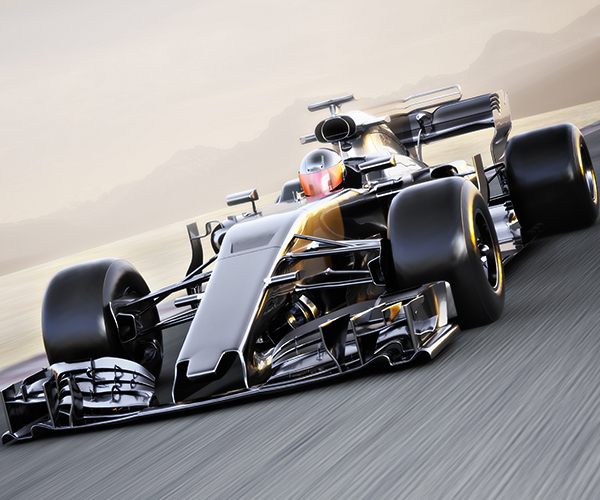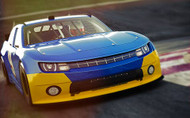Racing vs. Street Tires: What's the Difference?
Posted by Agota Szabo on Apr 6th 2022
Racing vs Street Tires: what actually is the difference between them?
If you follow motorsports series that involve sports cars, then you have probably noticed how unusual their tires are. Why is there no tread pattern? What's the big deal with these smooth, flat surface footprints?
Racing tires were introduced to the tire market in the late sixties and have evolved a lot since then. Most race tires are slick, although there are some models with detailed treads for wet conditions.
But why can't you install a racing tire on your car and give it a shot on the streets?
It turns out that there are huge differences in characteristics when it comes to road tires vs. racing tires. Below, we are going to delve into the details to show you why they are not made for the everyday driver.
Racing vs. Street Tires: What are they?
What is a Racing Tire?
A typical racing radial tire is designed with high performance in mind. They are manufactured for racing events that require specific tires to ensure maximum performance.
To achieve high performance capabilities, they need to sacrifice longevity. Racing tires are soft in order to keep traction consistent. They need to handle heat build-up at high speeds, turning heat into an advantage, using it to increase grip.

Racing tires have a short service life with a focus on short-term performance. It is about mustering as much as possible out of the vehicle in a few-hour window.
What is a Street Tire?
From a legal standpoint, a street tire has to have DOT (Department of Transportation) approval. Without this, it couldn't even be counted as a street tire, as it does not meet certain requirements.
Street tires come with a detailed tread, designed for versatile weather conditions. The tread is usually siped, or it at least has grooves to deal with hydroplaning in wet conditions. There are also sport tires available, which combine race- and road tire characteristics.

Street tires are manufactured to perform on asphalt, concrete, pavements, and oftentimes even off-road conditions. Winter tires, for example, are made for snow- and ice-covered surfaces.
Road tires come with a narrower tread and a sturdier compound. The emphasis is on longevity, stability, and low rolling resistance rather than raw performance. Many passenger tires are designed to absorb shocks for enhanced comfort levels.
Learn more about the importance of tire siping!
Racing vs. Street Tires: Differences
A racing car on the speedway really doesn't need tires that have a lifespan of tens of thousands of miles. Rather, it needs to be able to go as fast as possible while still being controllable.
Race tires are typically made of a combination of polymer and a dual-layer of particulate carbon. This rubber blend wears down fast, allowing only a couple of hundred miles of run time. They are usually used for a slim window of time, from thirty minutes to three hours.
As everyday drivers, we want our tires to last as long as possible. This is why street tire manufacturers use silica, kevlar plated radial plies, and durable rubber materials to ensure a long life for the tire. They often have complex structures to withstand challenging driving conditions.
Road tires are more versatile, while race track tires are designed with maximum speed and more grip in mind.
Racing vs. Street Tires: Why Racing Slicks are not for Street Use?
These tires come with a smooth surface area. Using them on a rainy day would cause your car to slip in every possible direction. This is dangerous during a race, forcing drivers to immediately go for a tire change.
Without a tread pattern, there is no way for the tire to disperse water from the footprint. Unlike road tires, smooth racing tires are designed for professional and amateur racers, and they don't comply with highway safety standards.

Besides, racing tires are expensive. Unless you are an amateur racer who has access to unlimited rubber, we would recommend some legal sports tires if you're looking to boost performance.
Different Types of Race Tires
Race track tires are designed depending on the conditions offered by the particular racing event. For example, a NASCAR tire is made of diverse rubber compounds and has different size parameters than a Formula One tire.
Seasoned engineers work on developing the right tires for each event. While Formula One tires are designed by Pirelli, Indy Car tires are designed by Firestone. The final product greatly depends on the track surface and various car specifications.
During each event, they offer a range of tires varying in softness and footprint. Let's see what the main characteristics of sport tires are in the most popular motorsports.
Indy Car Tires
At the American open-wheel car racing championship, called IndyCar, the tires are designed by Firestone. They offer three types of tires.
The first type are black tires that hit the balance between cornering, durability, and speed. Black tires feature a harder compound and are considered the main set in IndyCar racing.
The second type, red tires, serve as the softer alternative. Although they ensure better cornering, stability, and higher speeds than the black ones, they also wear down faster.
The third alternative is the rain tire which offers high wet weather track performance. This one has a grooved footprint for better grip in wet weather.
NASCAR
NASCAR is an exception here, in the sense that it features many vehicles that are stock racing cars. Each team then re-builds the basic setup to maximize the vehicle's speed and performance.
These run both an inner- and an outer tire for the event. If the outer tire blows, the driver still has the inner one, which will get them to the pit. NASCAR racing tires are made by Goodyear and they are almost completely smooth.
They design tires to maximize direct contact with the road surface. The compound they use depends on the upcoming event, as each track makes the tread wear differently. Goodyear engineers their tires for each track using different compounds.
Formula One
Formula One tires are called slicks, due to the fact that they boast such a smooth footprint. All of them are engineered by Pirelli, the company that has mastered its craft in F1 tires.
The rubber compounds used for these tires are especially rigid. This allows them to withstand extreme heat and improve performance. The compound can vary for F1 tires depending on the track conditions, the weather, and the car itself.

Their tires range from C1 to C5, where C1 is the hardest and C5 is the softest one. They also have two wet options to choose from, including the Cincurato Blue for full wet conditions and the Cincurato Green for intermediate wet pavement.
Racing Slicks
The most important rule for racing slicks is to achieve maximum rubber-to-road contact. These tires feature a tall sidewall and a wide tread. This ensures that they stick to the pavement with a large surface area. The point is to get the vehicle moving as fast as possible.
It has to be made from softer materials in order to maximize grip. It utilizes a soft sidewall and footprint to ensure grip during cornering as well. This significantly increases the tire wear rate.
Rain Tires
When the track is wet, racers have to put on rain tires. When we take a look at rain tires vs. smooth ones, they differ in the tread pattern. Rain tires utilize a detailed footprint with grooves that deal with hydroplaning.
By pushing water aside, the footprint can properly heat up and establish contact with the pavement for a consistent grip. These tires are only used on vehicles in inclement weather.
Frequently Asked Questions (FAQs)
Can you use racing tires on the street?
No, racing tires should not be used on the street, unless they have DOT (or equivalent) certifications. Racing tires are soft and are designed for high heat. Since there are no tread elements to deal with standing water and slush, the tire is susceptible to hydroplaning.
Do tires make a difference in racing?
Yes, the type of tire you use in racing makes a difference. Racing tires have a softer compound. The softer the tire, the faster it heats up, enhancing traction with the optimal contact patch. It sacrifices durability for maximum grip.
















